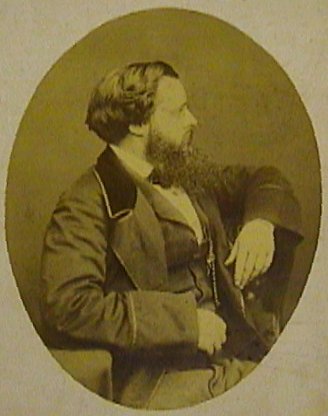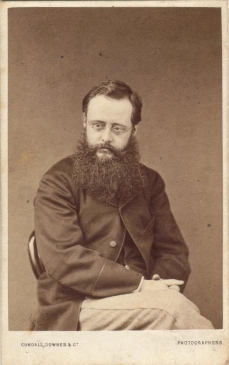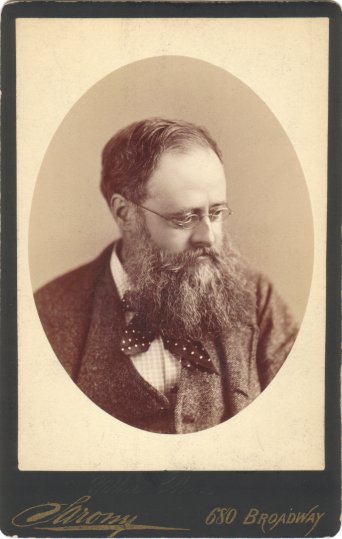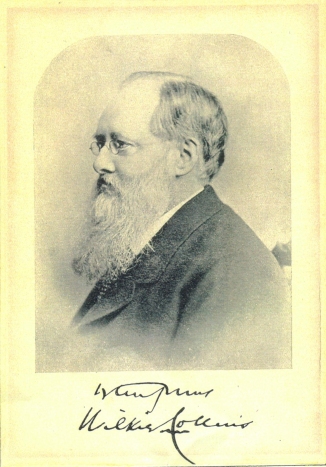Photographs of Wilkie Collins
This page deals just with photographs. There is also a
full chronological list of 80 images of
Wilkie Collins.
Quotations from letters are all taken from Baker, Gasson,
Law and Lewis
The
Public Face of Wilkie Collins London 2005.
Many photographs of Wilkie Collins exist. He had his picture taken many times and was always willing to send
copies to friends and to readers who wrote and asked. He admired the accuracy of
photography, but later came to recognise its limitations.
In 1851 he wrote of the portraits in the Summer Exhibition at the Royal Academy
"If this be portrait painting, how preferable are the daguerreotypes in the shop-windows!--they show us, at least, what the dignity and simplicity of nature really are."
'The Exhibition of the Royal Academy'
Bentley's Miscellany XXIX May 1851 p627
|

|
The first known a photograph of Wilkie Collins is a profile by the
London photographer Herbert Watkins. He operated from a shop at 215 Regent Street from about 1857 to 1873.
On 20 March 1858 Collins wrote to him to ask for three more impressions of "Your admirable (profile)
Photograph of me"
(Public Face I 157). A friend had taken Collins's copy and his mother wanted another.
This photograph was used as the basis of several engravings and at least one
watercolour. See Images of Wilkie. |
| His picture first reached a mass market in 1861. His publisher, Sampson Low, Son and Co., issued the first one-volume edition of the novel which had made his name - The Woman in White. Priced six shillings, 10,000 copies were initially printed and sales eventually far exceeded that. Tipped in before the engraved frontispiece was a photograph of Collins taken by the Cundall, Downes & Co. of 168 New Bond Street. In April 1861 Collins wrote to his friend Charles Ward that "I have to sit again, for the photographs can't keep up with us". Three years later he wrote to his mother to say "I must sit again to Cundall & Downes. All the 'negatives' of the
photographic portraits in The Woman in White are exhausted by the large sale".
Five examples of different photographs tipped into the 1861 volume are shown
here. |

|
|

|
In 1861 the photographer Herbert Watkins wrote to Collins to ask if he could take a full length picture of him for sale. Collins agreed but made him wait until after the one volume The Woman in White had been issued because
his publisher, Sampson Low, felt that another "photographic likeness of me will interfere with the effect which they hope to produce by publishing my portrait in the forthcoming edition of The Woman in White." However, he offered to sit in May that year and refuse all other offers for a full length picture.
He confirmed this arrangement on 20 May 1861 agreeing to a sitting "any day
after Wednesday next". So - assuming Watkins agreed promptly - the picture
was taken some time shortly after Wednesday 22 May 1861. Collins wrote Watkins
on 12 June "Many thanks for the portraits
which you have so kindly sent to me. All my friends who have hitherto seen
them, say they are admirable likenesses – and I who have no claim to be an
authority on this point, may at least add – as an impartial opinion of my
own – that they are also admirable photographs." Two
variants of this image are here. |
| By 1864 Cundall, Downes & Co. of 168 New Bond Street had
to take more pictures to illustrate The Woman in White. Wilkie wrote to his mother from Rome on 8 January 1864 "[When I return] I
must sit again to Cundall & Downes. All the
"negatives" of the photographic portraits in The Woman In White
are exhausted by the large sale - and, this time, I will take care that
some really good likenesses are produced." Wilkie returned in March
that year and this picture was probably taken around that date.
Another probably taken at this
sitting. |
 |
 |
This photograph by John and Charles Watkins of Parliament
Street was also probably taken in 1864. Wilkie wrote to Watkins (almost
certainly John) on 4 May 1864 apologising for his absence due to the weather
and asking to sit 'towards the latter part of this month". On 11 June he
wrote to his mother "I enclose two photographs (done by another
photographer). which seem to me to be the best likenesses yet
produced of me." |
|
The next known photograph is by Elliott & Fry of 55 Baker
Street, probably on 27 June 1866. He wrote to the firm on Monday 25th June
confirming his 'engagement to sit' on Wednesday. This image and others taken
at the same time were referred to by Wilkie in a
letter of 15
September 1866 to the future wife of a close friend. He says "I have sent specimens of three different “portraits of a gentleman”, in three different states of photographic suffering, to Farley Hill, and I have begged Messrs Elliot to place at your disposal any one of the portraits which you may honour with your choice."
Another taken at this sitting. |

|
| |
|
Wilkie's reference to the portraits depicting him in "states of
photographic suffering" echoes two references in his fiction around this
time to the harshness of photographic images.
In
Armadale - published in 1866 - he describes a young woman called Miss Milroy
'Her nose was too short, her mouth was too large, her face was too round and too rosy. The dreadful justice of photography would have had no mercy on her; and the sculptors of classical Greece would have bowed her regretfully out of their studios.'
And two years later in The Moonstone Collins uses a similar phrase about photography when the butler Gabriel Betteredge expresses his view of the pointless tasks that gentlefolk use to pass the time. One is
"staining your fingers in the pursuit of photography, and doing justice without mercy on everybody's face in the house."
Wilkie had borrowed this phrase from the portrait painter George Richmond RA
(1809-1896). On 22 March 1877 Wilkie wrote to the actor Frank Archer
'Thank you heartily
for the portrait. It is not only an excellent likeness, but, as I think, a
finely executed photograph.
You are in luck: it is not everybody who is well
treated by photography. Richmond (the
portrait painter) described photography
from his
point of view, as “Justice without Mercy!”'.
|
This photograph was published by the London Stereoscopic and Photographic
Company. The date is unknown but a reference on the back to Prize Medal for
Portraiture Vienna Exhibition 1873 sets the earliest date for publication.
However, Wilkie looks much younger in this picture than those of 1873-4 and it
is likely to have been taken earlier. It may even be a copy of the John and
Charles Watkins portrait. The LSPC seems to be a publisher rather than a
photographer. There is no reference to the company in Wilkie's known
letters. |

|
|
 |
This image is Elliott & Fry's second portrait of Wilkie, taken in
late 1871. Wilkie sent a copy of this picture to the New York publisher
Harper & Brothers with a letter saying it was "considered to be the best
that has ever been taken of me. If you have any future occasion to publish a
portrait of me, I can send you no better likeness (as I am told) for the
engraver to work from.". Harper took the hint, using an engraving based
on it frequently
over the next few years. |
| The next known photographs were taken during Wilkie's visit to the United States of America
from September 1873 to March 1874.
The image below was taken by a photographer called Warren, of
465 Washington Street in Boston during Collins's visit there
probably in October 1873 but possibly January 1874. Collins, born 8 January 1824, was 49 or 50 at this time.
Some versions of this picture have Warren's name and address clearly on the
reverse and his name or initial on the front. |
 |
 |
While in the United States, Wilkie was also photographed by the New York society
photographer, Napoleon Sarony. Evidence from Wilkie's own letters indicates they
were taken in 1874 and his only time in New York that year was 2 and 3
March. He was also in New York for a few days in September, October,
November and December 1873 and it is quite possible they were taken on one
of those occasions..
Born in Quebec in 1821, Sarony became a friend of
Wilkie's who admired his pictures enormously. Wilkie wrote to a correspondent on 13
March 1878 about his photographs "They came from New York, where the best
likenesses of me were taken three or four years since." A year later on 8
May 1879 he wrote to the Canadian publisher George Maclean Rose "My
photo: (which I also enclose) is by Sarony - done when I was last in New
York. Nothing half so good has been produced by anyone else." Four years
later on 17 February 1883 he wrote to the New York publisher William Bok "You
will find a choice of many admirable photographic portraits of me taken by my good friend Sarony...true works of Art, sold at most moderate prices. The English
photographs of me are not comparable to Sarony's."
|
| Again on 16 July 1884 Wilkie sent to the American writer
Paul Hamilton Hayne "...a really beautiful photograph portrait taken of me
by Sarony of New
York - ten years since. The more recent portraits, taken in England, are nothing
like so good as works of art." In some Sarony portraits Wilkie
wears a suit as above. In others he wears a fur coat over that suit and in
others still - as in the picture on the right - he wears the fur coat
apparently over a different suit. There are full length versions as well as
head and shoulders. Some reproductions of them by other publishers - with or
without authorisation - are also known.
There is also a stereoscopic
version of the image above.
Sarony's work remained Wilkie's favourite. On 19 May 1887 he wrote to the
publisher Andrew Chatto "A new supply of the
portrait enclosed has just reached me from New York – thanks to Sarony’s
kindness.
As a work of photographic art, it is
generally pronounced to be beyond the reach of any similar work here – and
on that account I slip it into my letter. Of the likeness (once remarkable)
the less now said the better! I was thirteen years younger, when I sat to
Sarony in New York.
What one of your authors was – will be the
right description of it." |
 |
|

Image © Susan Hanes 2005 |
This picture by Alexander Bassano is thought to date from
around 1880. Although in different clothes, Wilkie is clearly much the age
he is in the picture below. |
| This portrait by Lock & Whitfield was published as a Woodburytype in
his Men of Mark series in 1881 together with a short biography.
George Whitfield was after Wilkie for a portrait for some time. On 7 July
1877 Wilkie wrote to the publisher George Bentley saying that he had
asked him "to let me defer the sitting until I am stronger". It is thought
this image was taken in 1880. |
 |
|
Shortly after these pictures were taken
Wilkie again wrote about the horrors of being photographed. In a letter to Emily
Wynne dated 18 September 1885 he said
"Having a tooth out, having your hair cut, and having your photograph taken are the three great trials of this mortal life." |
|

Image © Andrew Gasson
2003 |
This image by an unknown photographer is probably the last
photograph taken of Collins, possibly as late at 1889. It was widely
reproduced as his obituary photograph after his death on 23 September that
year. |
Photographs 2.01
18 August 2005.
Full chronological list of 80 images of
Wilkie Collins
Paul Lewis front page
All material on these pages is © Paul Lewis 1997-2005